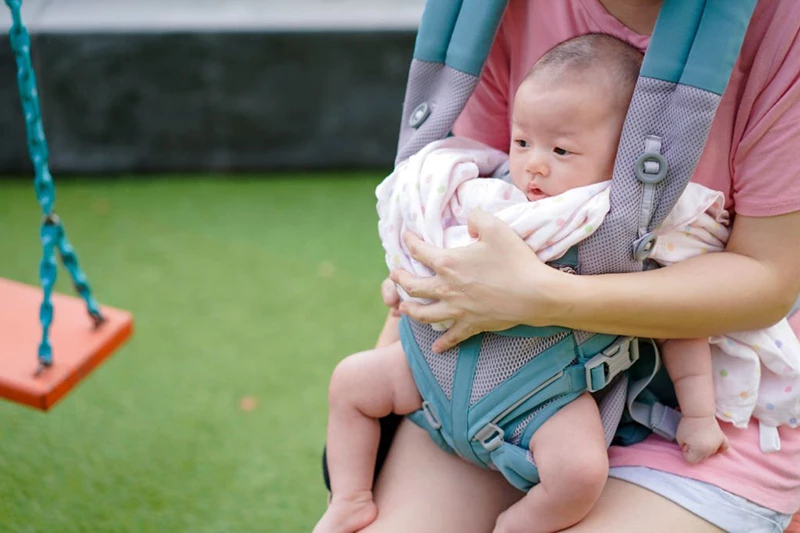Welcoming a new bundle of joy into the world is an extraordinary experience and being prepared is essential for both new and seasoned parents. One key item on your baby gear checklist should be a baby carrier—a marvelous invention that allows you to carry your little one while having your hands free to multitask. In today’s post, we’ll explore the crucial differences between ergonomic and non-ergonomic carriers, detailing the various benefits of each type and helping you determine the most appropriate option for you and your child.
Baby Carriers: The Basics
A baby carrier is a device that allows an adult to wear their baby comfortably and securely on their body while leaving their hands free to perform other tasks. The baby is either fastened to the wearer via straps and clips or wrapped securely using a piece of fabric. Baby carriers are gaining popularity as they help promote bonding between parent and child, improve a child’s sense of security, and make everyday tasks easier to manage.
Baby Carriers: A Lifesaver for Busy Parents
Baby carriers have come a long way, evolving over time to meet the needs of modern parents. These marvelous inventions provide caregivers with a convenient, hands-free way to carry their little ones, offering increased mobility while maintaining physical closeness and fostering bonding.
Baby carriers come in various designs, sizes, and materials, with the two primary categories being ergonomic and non-ergonomic. Understanding the differences will help you make an informed decision when choosing the best carrier for your child.
Ergonomic vs. Non-Ergonomic Baby Carriers
An ergonomic carrier is specifically designed to distribute your child’s weight evenly across your body, making it more comfortable for both the parent and the baby. In contrast, non-ergonomic carriers often lack proper support and may distribute your baby’s weight unevenly, potentially leading to discomfort and strain.
Distinct Features of Ergonomic Carriers
Weight Distribution:
Ergonomic carriers are constructed to evenly spread your child’s weight across your back, hips, and shoulders. This design helps to minimize strain and promote proper posture, reducing the chance of back pain and discomfort.
Customizable:
Many ergonomic carriers are adjustable to suit various body shapes and sizes, ensuring a snug, comfortable fit for both the parent and the baby.
Accommodating for Baby’s Growth:
Ergonomic carriers often feature adjustable seating and support features, allowing them to be easily adapted as your child grows.
Popular Ergonomic Brands in the Market
Today, many well-known brands offer ergonomic carrier options for parents:
- Ergobaby
- BabyBjörn
- Lillebaby
- Tula
Why Choose an Ergonomic Baby Carrier?
Ergonomic carriers offer a plethora of benefits for both parents and babies, including:
Improved Posture:
Ergonomic carriers are designed to distribute weight evenly, reducing strain on the lower back, neck, and hips.
Reduced Risk of Back Pain:
Because of the effective weight distribution, ergonomic carriers provide stability and relieve pressure on the spine. There are some baby carriers that can reduce the chances of back pain from carrying baby all day long.
Improved Comfort:
Wearer and baby alike will experience increased comfort due to the proper positioning and support provided by an ergonomic carrier.
Healthy Hip Development:
Placing the child in the natural “M” position supports their hip development and reduces the risk of hip dysplasia.
What to Look for When Choosing an Ergonomic Carrier
When navigating the vast world of baby carriers, consider the following factors:
- Look for adjustable, well-padded straps and a wide, supportive waistband, ensuring comfort for you and your baby.
- Seek out carriers made from soft, breathable materials that are easy to clean.
- Pay attention to weight limitations and growth accommodation to ensure long-lasting use.
Helpful Tips for Selecting the Perfect Carrier
- Prioritize your comfort and your baby’s safety by opting for an ergonomic carrier that evenly distributes weight and provides proper support.
- Whenever possible, test different models before purchasing to determine the best fit for you and your baby.
- Consult your pediatrician or a babywearing consultant for professional advice on selecting the right carrier and using it safely.
In conclusion, an ergonomic baby carrier offers unparalleled benefits for both the parent and child, ensuring comfortable, safe, and convenient babywearing experiences. Keep these guidelines and tips in mind when searching for the perfect carrier, and you’ll undoubtedly find the best choice to meet your family’s needs. Happy babywearing!



